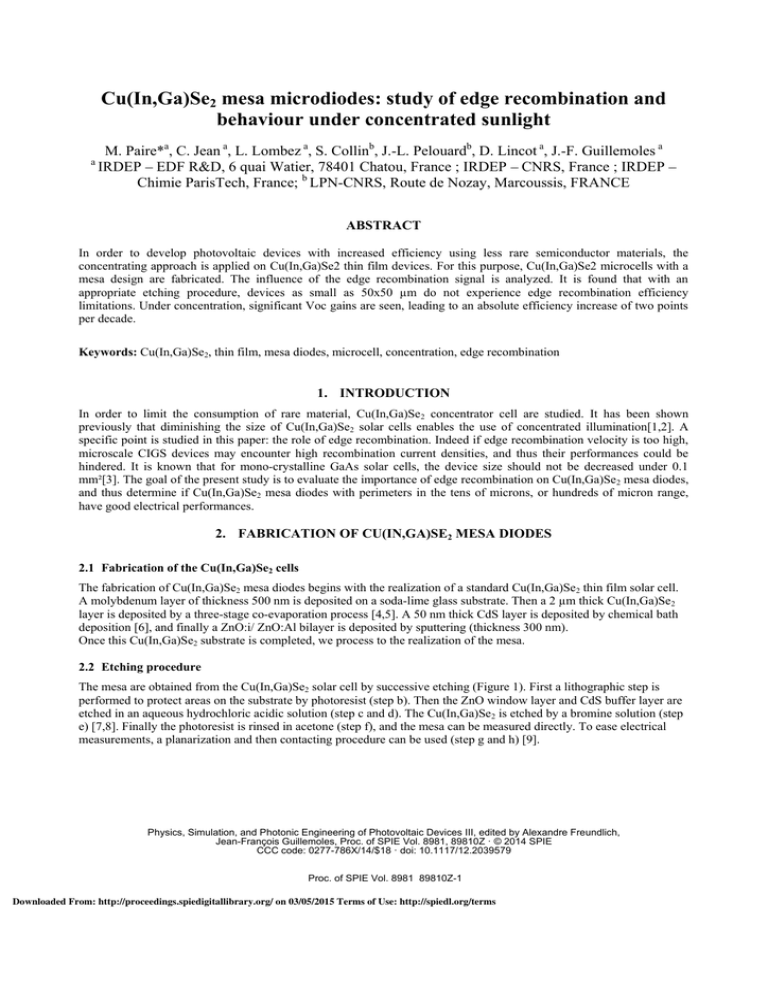Cu(In,Ga)Se2 mesa microdiodes: study of edge
advertisement

Cu(In,Ga)Se2 mesa microdiodes: study of edge recombination and behaviour under concentrated sunlight a M. Paire*a, C. Jean a, L. Lombez a, S. Collinb, J.-L. Pelouardb, D. Lincot a, J.-F. Guillemoles a IRDEP EDF R&D, 6 quai Watier, 78401 Chatou, France ; IRDEP CNRS, France ; IRDEP Chimie ParisTech, France; b LPN-CNRS, Route de Nozay, Marcoussis, FRANCE ABSTRACT In order to develop photovoltaic devices with increased efficiency using less rare semiconductor materials, the concentrating approach is applied on Cu(In,Ga)Se2 thin film devices. For this purpose, Cu(In,Ga)Se2 microcells with a mesa design are fabricated. The influence of the edge recombination signal is analyzed. It is found that with an appropriate etching procedure, devices as small as 50x50 µm do not experience edge recombination efficiency limitations. Under concentration, significant Voc gains are seen, leading to an absolute efficiency increase of two points per decade. Keywords: Cu(In,Ga)Se2, thin film, mesa diodes, microcell, concentration, edge recombination 1. INTRODUCTION In order to limit the consumption of rare material, Cu(In,Ga)Se2 concentrator cell are studied. It has been shown previously that diminishing the size of Cu(In,Ga)Se2 solar cells enables the use of concentrated illumination[1,2]. A specific point is studied in this paper: the role of edge recombination. Indeed if edge recombination velocity is too high, microscale CIGS devices may encounter high recombination current densities, and thus their performances could be hindered. It is known that for mono-crystalline GaAs solar cells, the device size should not be decreased under 0.1 mm²[3]. The goal of the present study is to evaluate the importance of edge recombination on Cu(In,Ga)Se2 mesa diodes, and thus determine if Cu(In,Ga)Se2 mesa diodes with perimeters in the tens of microns, or hundreds of micron range, have good electrical performances. 2. FABRICATION OF CU(IN,GA)SE2 MESA DIODES 2.1 Fabrication of the Cu(In,Ga)Se2 cells The fabrication of Cu(In,Ga)Se2 mesa diodes begins with the realization of a standard Cu(In,Ga)Se2 thin film solar cell. A molybdenum layer of thickness 500 nm is deposited on a soda-lime glass substrate. Then a 2 µm thick Cu(In,Ga)Se2 layer is deposited by a three-stage co-evaporation process [4,5]. A 50 nm thick CdS layer is deposited by chemical bath deposition [6], and finally a ZnO:i/ ZnO:Al bilayer is deposited by sputtering (thickness 300 nm). Once this Cu(In,Ga)Se2 substrate is completed, we process to the realization of the mesa. 2.2 Etching procedure The mesa are obtained from the Cu(In,Ga)Se2 solar cell by successive etching (Figure 1). First a lithographic step is performed to protect areas on the substrate by photoresist (step b). Then the ZnO window layer and CdS buffer layer are etched in an aqueous hydrochloric acidic solution (step c and d). The Cu(In,Ga)Se2 is etched by a bromine solution (step e) [7,8]. Finally the photoresist is rinsed in acetone (step f), and the mesa can be measured directly. To ease electrical measurements, a planarization and then contacting procedure can be used (step g and h) [9]. Physics, Simulation, and Photonic Engineering of Photovoltaic Devices III, edited by Alexandre Freundlich, Jean-François Guillemoles, Proc. of SPIE Vol. 8981, 89810Z · © 2014 SPIE CCC code: 0277-786X/14/$18 · doi: 10.1117/12.2039579 Proc. of SPIE Vol. 8981 89810Z-1 Downloaded From: http://proceedings.spiedigitallibrary.org/ on 03/05/2015 Terms of Use: http://spiedl.org/terms Figure 1. Fabrication F proccess of Cu(In,G Ga)Se2 mesa dioodes 2.3 Electricaal characterizzation The current-vvoltage characcteristics of the mesas are measured m both in the dark inn a four point-pprobe configu uration, and under illuminnation (AM1.55G illuminatioon, Newport class AAA solar simulator) in i a two pointt-probe config guration. We seek to determ mine an electrrical signal com ming from thee edges. Indeeed, we model the t total recom mbination currrent ✟✁✂/✁✄ as composed of a bulk and a perimeter p com mponent [10] : ✟✁✂ ✂/✁✄ ✏ ✑ ✎ ✒ ✁✂ ✁✂/✁✄,☎✆✝✞ ☎ ✂/✁✄ ,✠✡☛☞✌✡✍✡☛ ✑ ✓ And thus ✁✂/✁✄ ✏ ✁✂/✁✄ ✁ ,☎✆✝✞ ✒ ✁✂/✁✄ ,✠✡☛☞✌✡✍✡☛ ✑ ✓ ✎ Where ✁✂/✁✄,☎✆✝✞ and ✁✂/✁✄ e the saturatiooncurrent denssity associatedd to volume reecombination and to ✁ ,✠✡☛☞✌✡✍✡☛ are perimeter recombination reespectively, ✎ the mesa areaa and ✓ its perrimeter. Thus we expect to see a dependeence of the diode currentt density with respect to thee mesa geomettry. 3. EFF FECT OF TH HE MESA EDGE E ON ELECTRIC E CAL PERFO ORMANCES S OF THE DIODES D e sign nal form the edges e 3.1 Measureement of an electrical We measure the t current-vooltage characteeristics of the Cu(In,Ga)Se2 mesa diodes, and fit the cuurves by a two o-diode model (Figure 2 leftt). Then we ploot the current saturation dennsity, correspo onding to an ideality i factorr of 2, as a fun nction of the microcells areea (Figure 2 riight), as well as the open-ciircuit voltage under AM1.55 illumination.. Figure 2. (lleft) Example of o a measured current c voltage curve (red dotss) and its two diiode fit (black lline). The dotted d lines correspondd to the differennt components of o the fitting equuation (right) Saturation S currennt density J02 aand Open circu uit voltage under AM11.5G illumination as a functionn of the Cu(In,G Ga)Se2 mesa diode area. Proc. of SPIE Vol. 8981 89810Z-2 Downloaded From: http://proceedings.spiedigitallibrary.org/ on 03/05/2015 Terms of Use: http://spiedl.org/terms We can see that the saturation current densities, evaluated from dark measurements, are almost constant for mesa between 10-5 and 10-1 cm². It could be seen that the value even tends to decrease slightly for very small devices. The opposite behavior would be expected if a significant contribution to the recombination current was given by the edges, as the ratio perimeter/area is bigger for smaller devices. Thus, we can conclude that edge recombination effect is negligible on our devices. This indicates that bromine etches result in well passivated surfaces. As a consequence of this independence of dark currents on the mesa area, the open-circuit voltage is also constant (Figure 2). 3.2 Degradation of the surface In complement to the experiment described before, we intentionally degraded the Cu(In,Ga)Se2 surfaces by proceeding to a peroxide treatment, to see if the edge current become measurable. The sample is immersed in a aqueous peroxide solution for 1 mn and measured again afterwards. We observed a signal coming from the perimeter, as it is more intense of the smallest mesa. This signal is mainly a shunt current, as can be observed in Si microdiodes [11]. This behavior is logical as peroxide etches are known to degrade Cu(In,Ga)Se2 surface and form some metallic phases (indium and selenium for example), which could explain the apparition of shunt current [12]. 4. CONCLUSION We have fabricated Cu(In,Ga)Se2 microcells with a mesa design. The influence of the edge recombination was studied and is found very weak for Cu(In,Ga)Se2 solar cells. Indeed it is found that with an appropriate etching procedure, devices as small as 50x50 µm do not experience edge recombination efficiency limitations. Under concentration, significant Voc gains are seen, leading to an absolute efficiency increase of two points per decade. ACKNOWLEDGEMENT The authors would like to thank Isabelle Gerard and Arnaud Etcheberry for their help with the bromine solution preparation for Cu(In,Ga)Se2 etching. REFERENCES [1] [2] [3] [4] [5] [6] M. Paire, L. Lombez, J.-F. Guillemoles, and D. Lincot, Toward microscale Cu(In,Ga)Se2 solar cells for efficient conversion and optimized material usage: Theoretical evaluation,✁ J. Appl. Phys. 108, 034907 (2010). M. Paire, L. Lombez, N. Pere-Laperne, S. Collin, J.-L. Pelouard, D. Lincot, and J.-F. Guillemoles, Microscale solar cells for high concentration on polycrystalline Cu(In,Ga)Se[sub 2] thin films,✁ Applied Physics Letters 98, 264102 (2011). C. Algora, I. Rey-Stolle, B. Galiana, J. R. Gonzalez, M. Baudrit, and I. Garcia, Strategic options for a led-like approach in III-V concentrator photovoltaics,✁ in Conference Record of the 2006 IEEE 4th World Conference on Photovoltaic Energy Conversion, Vols 1 and 2, pp. 741✂744, IEEE, New York (2006). M. Paire, L. Lombez, F. Donsanti, M. Jubault, S. Collin, J.-L. Pelouard, J.-F. Guillemoles, and D. Lincot, Cu(In, Ga)Se2 microcells: high efficiency and low material consumption,✁ Journal of Renewable and Sustainable Energy 5, 011202 (2013) [doi:10.1063/1.4791778]. T. klinkert, M. Jubault, F. Donsanti, D. Lincot, and J.-F. Guillemoles, Diffusion Phenomena during Multi-Stage Co-Evaporation Processes of CIGS Solar Cells,✁ in Proceedings of the 28th European Photovoltaic Solar Energy Conference and Exhibition CdTe, CIS and Related Ternary and Quaternary Thin Film Solar Cells, pp. 2453 ✂ 2454, Paris, France (2013) [doi:10.4229/28thEUPVSEC2013-3BV.6.56]. N. Naghavi, D. Abou-Ras, N. Allsop, N. Barreau, S. Bücheler, A. Ennaoui, C.-H. Fischer, C. Guillen, D. Hariskos, et al., Buffer layers and transparent conducting oxides for chalcopyrite Cu(In,Ga)(S,Se)2 based thin film photovoltaics: present status and current developments,✁ Progress in Photovoltaics: Research and Applications 18, 411✂433 (2010) [doi:10.1002/pip.955]. Proc. of SPIE Vol. 8981 89810Z-3 Downloaded From: http://proceedings.spiedigitallibrary.org/ on 03/05/2015 Terms of Use: http://spiedl.org/terms [7] Z. Jehl, F. Erfurth, N. Naghavi, L. Lombez, I. Gerard, M. Bouttemy, P. Tran-Van, A. Etcheberry, G. Voorwinden, et al., Thinning of CIGS solar cells : Part II: cell characterisations,✁ Thin Solid Films 519, 7212✂7215 (2011). [8] B. Canava, J. F. Guillemoles, J. Vigneron, D. Lincot, and A. Etcheberry, Chemical elaboration of well defined Cu(In,Ga)Se2 surfaces after aqueous oxidation etching,✁ Journal of Physics and Chemistry of Solids 64, 1791✂ 1796 (2003). [9] M. Paire, Highly efficient solar cells in low dimensionality based on Cu(In,Ga)Se2 chalcopyrite materials,✁ PhD dissertation, UPMC (2012). [10] P. E. Dodd, T. B. Stellwag, M. R. Melloch, and M. S. Lundstrom, Surface and perimeter recombination in GaAs diodes: an experimental and theoretical investigation,✁ Electron Devices, IEEE Transactions on 38, 1253✂1261 (1991). [11] K. Nishioka, N. Sakitani, Y. Uraoka, and T. Fuyuki, Analysis of multicrystalline silicon solar cells by modified 3diode equivalent circuit model taking leakage current through periphery into consideration,✁ Solar Energy Materials and Solar Cells 91, 1222✂1227 (2007) [doi:10.1016/j.solmat.2007.04.009]. [12] T. Delsol, M. . Simmonds, and I. . Dharmadasa, Chemical etching of Cu(In,Ga)Se2 layers for fabrication of electronic devices,✁ Solar Energy Materials and Solar Cells 77, 331✂339 (2003) [doi:10.1016/S09270248(02)00352-5]. Proc. of SPIE Vol. 8981 89810Z-4 Downloaded From: http://proceedings.spiedigitallibrary.org/ on 03/05/2015 Terms of Use: http://spiedl.org/terms
